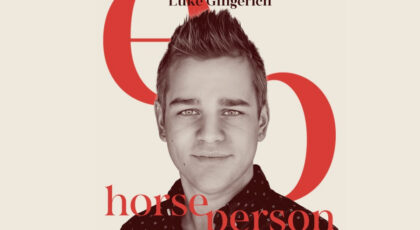You’ll meet a lot of different people at a trail stable, from those with heaps of false confidence to the shaking kids who are terrified to mount.
I’ve spent four seasons working as a trail guide, taken out hundreds of riders, and I’ll admit that some of the characters do begin to feel…familiar.
So, like the horses you’ll meet at a trail stable, I’ve sorted trail riders into seven highly scientific categories.
1. The “wrangler”
This is the person who replies “all my life!” when you ask if they’ve ever ridden a horse. Usually, that means they used to sit on their neighbour’s pony once a year when they were a kid. They will show up in brand-new, squeaking boots and a belt buckle so shiny it nearly blinds you when the sun catches it. I actually like these people, most of the time. I love their enthusiasm. I don’t like it when you get a “wrangler” who brags nonstop about their extensive riding experience (read: a three-day stay at a dude ranch) and tries to give you tips on horses.
2. The humble one
The opposite of the “wrangler”—when you ask about their riding experience, they’ll shrug and modestly say, “Oh, a few times.” Within seconds of mounting, they’re holding the reins correctly, their heels are down, and they require no instructions on how to stop, go, or steer. They intentionally underrate their own experience, because they don’t want to be stuck with a difficult horse for the next two hours—but they might also become exasperated if they end up with an ol’ dependable horse.
Luckily, there is a way to scout out these people: their footwear. Take a look at their extremely worn boots, and you’ll be able to match them with a horse that’s neither terror nor slowpoke, but awake, fun, and responsive.
3. The silent one
This person will give one- or two-word responses to your attempts at small talk and will vaguely nod when you share fun facts about the area. You spend most of the ride wondering if they’re miserable or in some sort of pain they’re too shy to mention. And yet as soon as they get off, a glowing smile appears, and they press a bill into your hand while enthusing about what a great time they had. They may try to hug you. You will be left baffled, but smiling.
4. The selfie taker
They might blast music, lose their selfie stick to a pine tree, or even livestream part of the ride (all of these have actually happened). When I first started as a trail guide, the selfie takers used to bother me, because I thought they should be looking at the world around them with their eyes, and not just through the lens of their camera phone. But after a couple seasons, I learned to love these people. They usually required very little banter from me, and they got exactly what they wanted out of the experience. They would dismount at the end of the ride laughing at how sore they were, ask to try on my cowboy hat (always a no), and still leave smiling.
5. The screamer
Also known as the “first time rider,” the “I rode a horse once 20 years ago and fell off” or the “IS THAT A BEE? I’M NOT ALLERGIC BUT I HATE THEM!” I have had the bad luck of once assuring a screamer who was terrified of bears that we would certainly not be seeing any that day, only to turn the corner and find ourselves face-to-face with a grizzly. I have learned that the best way to deal with screamers is to make them no promises (horses are unpredictable, after all) and instead just appear perfectly relaxed about everything. If you can act like you’re not worried about it, it may just help them relax, too, and begin to enjoy their experience.
6. The kid who prefers soccer
They are clearly on the ride because it was their horse-obsessed sister/mother/aunt’s turn to pick the activity, and they’re (hopefully) being a good sport about it. They might seem unenthused, but keep at it—mention that horses can play soccer, too, or share that their horse, like them, hates Mondays!—and you might just be able to spark an interest in horses.
7. The one you connect with
The rarest, but most rewarding, of riders. I find the best connections happen on longer rides: three hours in the saddle gives you lots of time to bond. I’ve found true connections with solo riders, pairs of couples, and families; people who have asked intelligent questions and remembered the answers, and people who share their own hard-won life lessons. Advice from riders has included everything from: “it’s never too late to start over again in life” to “if you’re happy with yourself, it makes it easier to be happy with someone else,” to my personal favorite: “there’s some kind of beauty in every part of this world.” All these conversations happened on horseback.
See, that’s the beautiful thing about trail riding. You never know who you’re going to meet. Sometimes people can surprise you. And those moments where you let the silence rest, hearing the horse’s hoofbeats through the forest, can lead to great conversation and more. In those silences, if you’re lucky, you’ll glance over your shoulder and notice: your riders are breathing a little easier. They’re settling a little deeper into the saddle, gazing at their surroundings, reaching down occasionally to pat their horse. They’re getting to experience something they normally don’t. And I’m so grateful I got to be there for all of those moments.




 June 11, 2021
June 11, 2021 




























